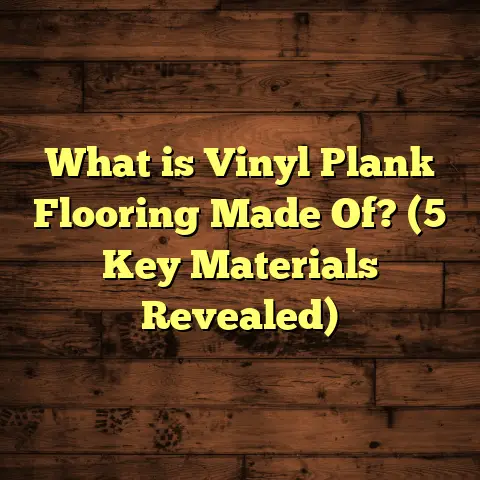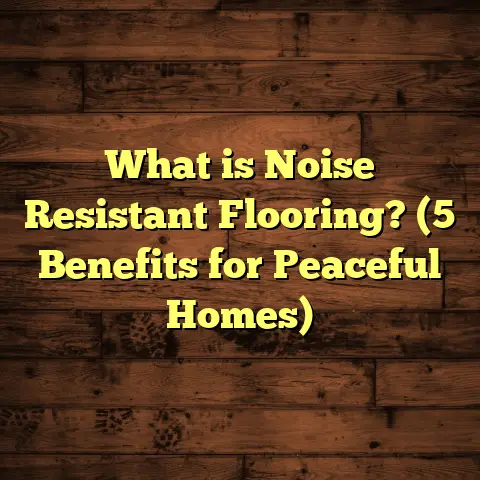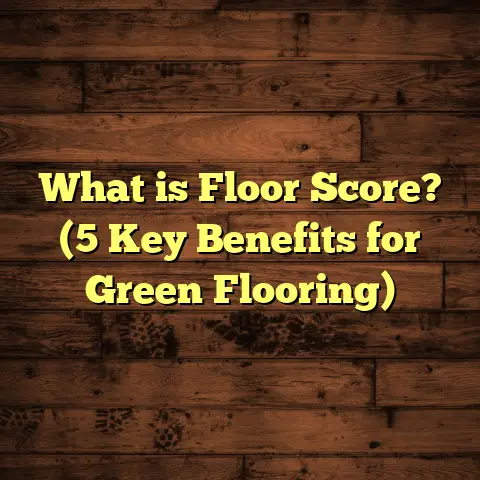What is Resilient Flooring Material? (5 Benefits for Your Home)
I’ve always loved helping homeowners find flooring solutions that work both practically and aesthetically. Over the years, I’ve realized how resilient flooring is an underrated hero in many homes. It offers a unique blend of toughness and comfort that works well for families, pet owners, and anyone wanting long-lasting floors without all the fuss. If you’re curious about what makes resilient flooring special, stick with me. I’ll share everything I’ve learned from my projects, including insider tips and real-life stories.
What is Resilient Flooring Material?
Resilient flooring is a category of flooring products characterized by their ability to flex and recover from impacts or pressure without permanent damage. Unlike rigid floors such as ceramic tile or natural stone, resilient floors have a soft backing or surface layer that gives them a slight “spring” or cushioning effect.
Resilient flooring includes materials like:
- Vinyl (sheet vinyl, luxury vinyl tiles/planks)
- Linoleum
- Cork
- Rubber
Each of these has unique properties, but what ties them together is their flexibility and durability.
Vinyl is probably the most common resilient floor in residential settings today. It’s made from PVC (polyvinyl chloride), often layered with a printed design layer and a protective wear layer on top. Over time, vinyl has evolved to not only be durable but also highly customizable in appearance, mimicking wood, stone, or tile.
Linoleum is a natural product made from linseed oil, cork dust, wood flour, and other natural materials. It’s biodegradable and has been used for decades in homes and commercial spaces.
Cork floors are made from the bark of cork oak trees. The natural cellular structure of cork adds softness and warmth underfoot.
Rubber flooring is often found in gyms or play areas due to its high shock absorption and slip resistance.
When I first started working with resilient flooring, I was impressed by how versatile it could be. One client wanted a kitchen floor that looked like hardwood but was easy to maintain. Luxury vinyl planks were perfect—they got the wood look without the worry about water damage or scratches.
Why Resilient Flooring Became My Go-To Recommendation
In my early days as a flooring contractor, I mostly worked with hardwood and tile. These materials are beautiful but can be high maintenance or expensive. Over time, I saw many clients struggle with hardwood floors warping due to moisture or tile cracking from dropped objects.
Resilient flooring offered a middle ground: durable enough for daily wear but forgiving enough to handle accidents. Plus, the range of designs meant clients didn’t have to sacrifice style for practicality.
One memorable project was for a family with young kids and an active dog. They wanted floors that could survive spills, scratches, and heavy foot traffic but still feel warm and inviting. We installed cork in their playroom and luxury vinyl plank throughout the main living area. Their feedback after six months? The floors looked great, were easy to clean, and felt comfortable for their kids to play on.
5 Benefits of Resilient Flooring for Your Home
1. Durability That Stands Up to Life
Durability is probably the biggest reason I recommend resilient flooring. These materials are designed to take a beating — foot traffic, dropped objects, pet claws — without showing wear quickly.
For example:
- Luxury vinyl planks have wear layers measuring between 6 mils (moderate use) up to 40 mils (commercial grade). The thicker the wear layer, the more resistant it is to scratches and dents.
- Cork naturally resists cracking and chipping due to its cellular structure.
- Rubber floors absorb impact energy, so they don’t crack or dent easily.
Data from the Resilient Floor Covering Institute (RFCI) shows that resilient floors can last anywhere from 10 to 25 years depending on care and product quality. This longevity is impressive when compared to carpet (which may need replacing every 7-10 years) or some hardwoods prone to deep scratches.
In one project where I installed sheet vinyl in a busy retail shop, the floor maintained its integrity after several years of heavy foot traffic and rolling carts — proof that it’s not just for homes.
2. Comfort Underfoot Makes a Difference
Have you ever stood on cold tile or hard wood for hours? It can be exhausting on your feet and joints.
Resilient floors provide a softer surface that adds comfort without sacrificing durability. Cork floors are particularly popular for this reason—they offer natural cushioning that reduces fatigue.
Rubber flooring is another good option if you want anti-fatigue benefits. It’s common in gyms because it absorbs shock well.
In my experience installing floors in kitchens and gyms, clients always remark on how much more pleasant their floors feel after switching to resilient options. One yoga instructor told me her cork floors made standing poses way easier on her knees.
3. Water Resistance Keeps Floors Looking New
Moisture can wreck many types of flooring fast. Hardwood swells and warps; carpets absorb smells; some tiles crack if water seeps underneath.
Resilient floors like vinyl and rubber excel in wet areas because they resist water penetration. This makes them ideal for kitchens, bathrooms, basements, and laundry rooms.
A client who remodeled her basement with luxury vinyl planks shared how relieved she was that minor flooding didn’t ruin her floors.
Linoleum also has some water resistance but requires periodic sealing to maintain protection.
From my perspective, water resistance means less worry about damage from everyday spills or accidents—something many families appreciate.
4. Easy Maintenance Saves Time and Energy
I know how busy life gets—and cleaning floors isn’t anyone’s favorite chore.
Resilient flooring’s simple upkeep is one reason it’s so popular. Sweeping regularly and mopping with mild cleaners keeps these floors looking great for years.
Unlike carpets that trap dust or hardwoods needing special cleaners or refinishing, resilient floors are pretty low maintenance.
I always tell clients: “If you can mop your kitchen counters easily, you can clean resilient floors.” It’s that straightforward.
Plus, no waxes or polishes are needed like some other flooring types require.
This ease means less time cleaning and more time enjoying your home.
5. Cost-Effective with Great Style Options
Budget is often a major factor in choosing flooring. Resilient options generally cost less upfront than hardwood or natural stone but still deliver attractive looks.
Luxury vinyl planks can mimic wood grains beautifully at a fraction of the price—often between $3-$7 per square foot installed compared to hardwood’s $8-$15 per square foot.
Linoleum costs vary but are usually affordable given its durability and eco-friendly appeal.
I’ve seen homeowners stretch their remodeling budget by choosing resilient flooring in key areas while saving hardwood for smaller spaces or accents.
Using tools like FloorTally has been a lifesaver for me during budgeting phases. It lets me input local labor rates and materials prices to get realistic estimates quickly. Plus, it accounts for waste material so we don’t run short or overspend on leftover stock.
Personal Tips From Years of Flooring Installations
Here are some things I’ve learned that might help you if you’re considering resilient flooring:
Prepare Your Subfloor Carefully
A clean, flat subfloor makes all the difference for a smooth resilient floor installation. Uneven surfaces can cause bumps or premature wear.
Before installing any resilient floor, I always check for moisture levels and repair any cracks or dips in the subfloor.
Thickness Matters
Thicker resilient flooring offers more comfort but costs more upfront. Thinner options may be fine for low-traffic rooms but less forgiving in busy areas.
Ask your installer about thickness options based on where you plan to use the floor.
Use Underlayment When Possible
Underlayment adds cushioning and soundproofing benefits. It’s especially useful under luxury vinyl planks or cork floors.
I recommend investing in good underlayment if you want quieter rooms and softer steps.
Match Flooring To Room Conditions
Moisture-prone rooms need waterproof resilient materials like vinyl or rubber rather than cork which can absorb water if not sealed properly.
If installing in basements or bathrooms, ask about waterproof warranties or special installation techniques.
DIY Installation Can Work—but Be Realistic
Some resilient flooring products come with click-lock systems making them easier for homeowners to install themselves.
However, complex patterns or uneven subfloors may require professional help to ensure durability.
Case Study: Transforming a Family Home with Resilient Flooring
Last year I worked with a family renovating their entire main floor: kitchen, living room, hallway—you name it. They had three young kids running around plus pets adding extra wear-and-tear potential.
The homeowners wanted durable floors but didn’t want cold tile or high-maintenance hardwood everywhere. After evaluating their needs, we chose luxury vinyl planks for most living areas and cork flooring in the playroom.
The results were fantastic:
- The kids loved playing on the warm cork floor.
- The kitchen floor handled spills easily.
- Cleaning time dropped significantly.
- Noise levels decreased thanks to soft resilient materials absorbing sound.
- The budget stayed within projected costs thanks to careful planning using FloorTally estimates which included waste factors and labor costs based on local rates.
The family told me they felt like their home had become more welcoming yet practical at the same time—a win-win outcome from resilient flooring choices.
Interesting Data Points You Might Like
- According to RFCI data from 2023, residential sales of luxury vinyl tile (LVT) grew by over 15% annually over the past five years.
- Cork flooring has been shown in lab settings to reduce ambient noise levels by up to 30% compared to hardwood.
- Over 60% of homeowners who switched from carpet to resilient floors reported lower allergy symptoms due to less dust trapping.
- The average lifespan of luxury vinyl flooring with proper maintenance can exceed 20 years.
- Homeowners spend roughly 30% less time cleaning resilient floors compared to carpeted rooms (source: National Floor Safety Institute).
These figures back up what I’ve experienced firsthand—resilient flooring combines durability with comfort and practicality better than many other options around today.
How FloorTally Helps Me Manage Flooring Projects Efficiently
Budgeting is one of the trickiest parts of any home renovation project. Overestimating leads to wasted money; underestimating means delays and headaches later on.
FloorTally has become my favorite tool because it consolidates all cost factors—materials, labor rates based on location, waste percentages—into one easy interface. This saves me hours I used to spend gathering multiple quotes separately from suppliers and contractors.
For example:
- I enter the room dimensions and select material types.
- FloorTally calculates total square footage plus waste allowance.
- It pulls local labor rates automatically.
- It gives me a detailed cost breakdown so I can tweak choices if needed.
- I print reports for clients so everyone stays clear on budget expectations.
Using FloorTally means fewer surprises during installation and helps me offer clients realistic budgets upfront—something everyone appreciates when planning renovations.
Common Questions I Get About Resilient Flooring
Q: Will resilient floors fade over time?
A: High-quality resilient flooring usually has UV-resistant coatings that prevent fading from sunlight exposure. However, extended direct sunlight may cause some color changes depending on material quality.
Q: Can I install resilient flooring over existing floors?
A: In many cases yes—as long as the existing floor is flat and stable (e.g., concrete slab or well-adhered vinyl). Removing old carpet or damaged wood is usually necessary first.
Q: How do I prevent seams from showing?
A: Proper installation with precision cutting helps minimize visible seams. Sheet vinyl offers fewer seams than tiles but requires expert installation for best results.
Q: Is resilient flooring eco-friendly?
A: Some options like linoleum and cork are made from natural renewable materials. Vinyl is synthetic but newer lines include recycled content and are recyclable at end of life.
Wrapping Up My Thoughts on Resilient Flooring
After all my years working hands-on with different types of flooring materials—resilient flooring has proven itself again and again as practical, stylish, and cost-effective. It fits so many lifestyles from busy families to pet owners who need durable yet comfortable surfaces underfoot.
If you want floors that handle spills gracefully while offering warmth underfoot—and save you time cleaning—resilient options deserve serious thought for your home upgrade plans.
And if budgeting feels overwhelming? Tools like FloorTally can make all the difference by giving you transparent cost estimates based on your specific location and project needs—helping turn your vision into reality without surprises along the way.
Thinking about your next flooring project? Don’t hesitate to reach out if you want advice tailored specifically for your home’s needs—I’d love to share more insights!
If you want me to add more detail on any specific type of resilient flooring (vinyl vs cork vs rubber) or installation tips, just let me know!





